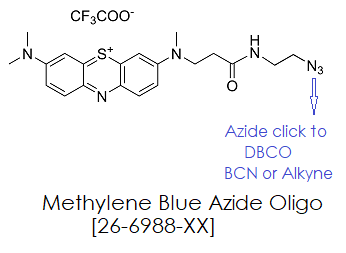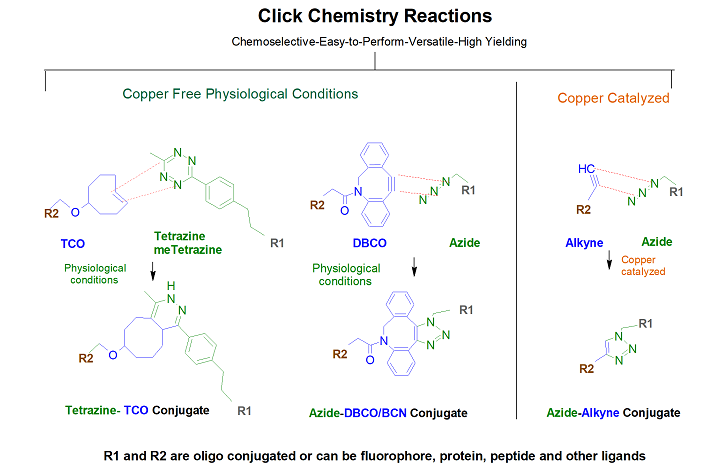
Modification : Methylene Blue Azide
Catalog Reference Number
Category
Modification Code
5 Prime
3 Prime
Internal
Molecular Weight (mw)
Extinction Coeficient (ec)
Technical Info (pdf)
Absorbance MAX
Emission MAX
Absorbance EC
26-6988
Redox Electrochemical
[MB-N3]
Y
Y
Y
553
-
PS26-6988.pdf
662
-
-
| Catalog No | Scale | Price |
| 26-6988-05 | 50 nmol | $702.00 |
| 26-6988-02 | 200 nmol | $702.00 |
| 26-6988-01 | 1 umol | $913.00 |
| 26-6988-03 | 2 umol | $2,754.00 |
| 26-6988-06 | 5 umol | $4,108.50 |
| 26-6988-10 | 10 umol | $7,301.00 |
| 26-6988-15 | 15 umol | $9,126.00 |
This modification is a post synthesis conjugation to BCN, alkyne or DBCO modification at the appropriate site for click conjugation. Gene Link offers post synthesis click free conjugation to oligos labelled with BCN at the 5' or 3' end. The azide group of Methylene Blue is linked to BCN group on the oligo. BCN group is required on the oligo. Additional charges applies for BCN
BCN-3
BCN-5
YIELD
Post synthesis conjugation modifications yields are lower as compared to direct automated coupling of modifications that are available as amidites. Approximate yield for various scales are given below.
~2 nmol final yield for 50 nmol scale synthesis.
~5 nmol final yield for 200 nmol scale synthesis.
~16 nmol final yield for 1 umol scale synthesis.
Methylene Blue Azide is a derivative of the well-known redox dye Methylene Blue. The azide derivative enables use in copper free click chemistry reactions with DBCO labelled reactants.
The dye can be reversibly reduced to the colorless leuko form. Upon oxidation (e.g. with
oxygen) the dye recovers, and the absorption is fully restored.
Methylene Blue (e.g Atto MB2) NHS is a redox-active, heterocyclic aromatic dye that, when incorporated at the 5' or 3'-end of an oligonucleotide, enables the modified oligo's use as an electrochemical (EC) probe for nucleic acid analysis. Currently, there is considerable interest in using MB-modified oligonucleotides as aptamer probes for developing electrochemical DNA sensors for selective and sensitive detection of specific biochemical targets (DNA, RNA, proteins, etc.) in complex samples (for example, blood serum) (1,2). Such sensors are constructed by covalent attachment (typically through one or more thiol groups) of the MB-modified DNA probes to the surface of a gold electrode. The binding of target to probe leads to changes in the structural dynamics of the probe DNA that change the distance between the MB moiety and the gold surface. For "signal-on" sensors, the MB moiety moves close enough to the gold surface to cause electron transfer between the two, and generation of an electrochemical signal indicating presence of target in the sample (3). For "signal-off" sensors, the MB moiety moves away from the gold surface, halting electron transfer between the two, with the subsequent loss of an electrochemical signal indicating presence of target in the sample (4). Intensive work continues to move these systems beyond proof of principle and towards commercial availability.
Methylene blue is a pH indicator that changes color depending on the acidity or alkalinity of a solution. In acidic conditions (pH < 6), it appears blue, while in neutral to basic conditions (pH > 7), it can shift to a colorless or light blue form. This transition is due to changes in the molecular structure of methylene blue, which affects its light absorption properties.

References
1. Ricci, F., Lai, R.Y., Plaxco, K.W. Linear, redox modified DNA probes as electrochemical DNA sensors.
Chem. Comm. (2007),
36: 3768-3770.
2. Song, S., Wang, L., Li, J., Zhao, J., Fan, C. Aptamer-based biosensors.
Trends in Anal. Chem. (2008),
27: 108-117.
3. Ferapontova, E.E., Gothelf, K.V. Optimization of the Electrochemical RNA-Aptamer Based Biosensor for Theophylline by Using a Methylene Blue Redox Label.
Electroanalysis (2009),
21: 1261-1266.
4. Xiao, Y., Lubin, A.A., Heeger, A.J., Plaxco, K.W.. Label-free Electronic Detection of Thrombin in Blood Serum by Using an Aptamer-Based Sensor.
Angew. Chem. Int. Ed. Engl. (2005),
44: 5456-5459..
Copper-free Click Chemistry Modifications
Use azide modified oligos with DBCO Cyclooctyne-based modifications for ease of copper-free click reagents. These are simple to use and has excellent click performance in 17 hours or less at room temperature. Gene Link offers 5'-DBCO-TEG for preparing oligos with 5’-DBCO and a 15 tom triethylene glycol spacer arm, DBCO-dT for inserting a DBCO group at any position within the oligonucleotide and DBCO-sulfo-NHS Ester is also offered for post-synthesis conjugation reactions. DBCO-modified oligos may be conjugated with azides in organic solvents, such as DMSO, or aqeous buffers. Depending on the azide used, the reaction will go to completion in 4-17 hours at room temperature.
Azide C3 is available to introduce a stable azide group at the 3' of an oligo. Use Azide butyrate NHS [26-6922] for introduction of azide at internal or 5' position by conjugating to an amino-modified oligonucleotide. Introduction can be done at either the 5'- or 3'-end, or internally. To do this, the oligo first must be synthesized with a primary amino functional group modification, e.g Amino C6 for the 5' end or amino C7 for the 3' end for the ends) or the amino C6 version of the base phosphoramidite (for internal labeling). The Azidobutyrate NHS ester is then manually attached to the oligo through the amino group in a separate reaction post-synthesis.
The presence of the azide allows the user to use "Click Chemistry" (a [3+2] cycloaddition reaction between alkynes and azides, using copper (I) iodide as a catalyst) to conjugate the azide-modified oligo to a terminal alkyne-modified oligo with extremely high regioselectivity and efficiency (1,2). Preparation of the alkyne-modified oligo can be achieved using the 5’-Hexynyl modifier (see its respective tech sheet for details). Click chemistry can be used to form short, cyclic oligos that can be used as research tools in various biophysical and biological studies (3). In particular, they have considerable potential for in vivo work, as cyclic oligos are known to be very stable in serum for up to several days.
 References
References
1. Huisgen, R.
Angew. Chem. Int. Ed. (1963),
2]: 565-568.
2. Rostovtsev, V.V., Green, L.G., Fokin, V.V., Sharpless, K.B. A Stepwise Huisgen Cycloaddition Process: Copper(I)-Catalyzed Regioselective Ligation of Azides and Terminal Alkynes.
Angew. Chem. Int. Ed. (2002),
41: 2596-2599.
3. Kumar, R., El-Sagheer, A., Tumpane, J., Lincoln, P., Wilhelmsson, L.M., Brown, T. Template-Directed Oligonucleotide Strand Ligation, Covalent Intramolecular DNA Circularization and Catenation Using Click Chemistry.
J. Am. Chem. Soc. (2007),
129: 6859-6864.
- Methylene Blue (MB2-Azide)
